Valve Corporation Bundle
How Does Valve Corporation Thrive in the Gaming World?
Valve Company, a privately held powerhouse, has revolutionized the video game industry, shaping how we play, buy, and experience games on PC. With its massive Steam platform, boasting millions of active users, Valve's influence is undeniable. But how does this elusive giant actually operate, and what secrets fuel its continued success?
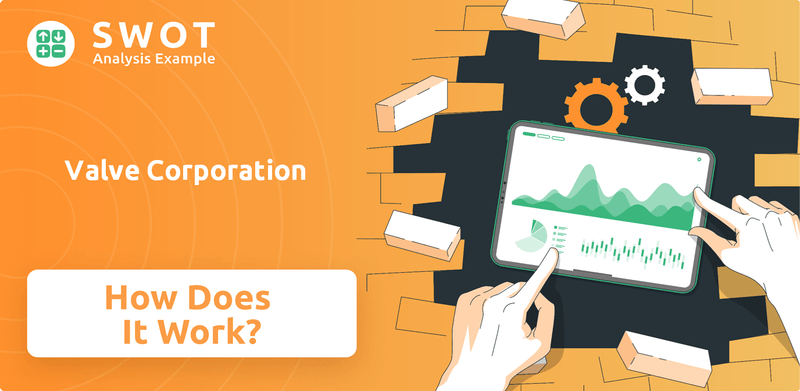
This exploration will uncover the inner workings of Valve, from its innovative approach to game development to its dominant Steam marketplace. Understanding Valve's business model is key for anyone interested in the gaming landscape, offering insights into digital distribution, community building, and sustained profitability. To further understand the company's strategic position, consider a detailed Valve Corporation SWOT Analysis to understand its strengths, weaknesses, opportunities, and threats. We'll also delve into the history of Valve, its most popular games, and the leadership of Gabe Newell to understand how this video game developer became a leader.
What Are the Key Operations Driving Valve Corporation’s Success?
The core operations of Valve Corporation, often referred to as Valve Company, pivot around two main areas: video game development and the operation of the Steam platform. As a video game developer, Valve creates and publishes successful game franchises. These games, such as the Half-Life series, Counter-Strike 2, Portal, and Dota 2, are key to their business model.
The Steam platform is central to Valve's value proposition. It serves as a comprehensive ecosystem for PC gamers and developers. For gamers, Steam offers a vast library of titles, digital rights management, automatic updates, social features, cloud saves, and a marketplace for in-game items. For developers, Steam provides a distribution channel, marketing tools, analytics, and a revenue-sharing model.
Valve's operational processes include continuous platform development and maintenance, robust server infrastructure, a sophisticated content delivery network (CDN), and a dedicated customer support system. Their supply chain is primarily digital, relying on its own infrastructure and partnerships with internet service providers for content delivery. The distribution network is global, accessible wherever internet connectivity allows. Valve's unique approach includes iterative development, a flat organizational structure, and a deep understanding of the PC gaming community.
Valve develops and publishes games, including popular titles like Counter-Strike 2 and Dota 2. These games are not only sources of direct revenue but also drive engagement on the Steam platform. Valve's proprietary Source engine is used in many of their games, showcasing their technological capabilities.
Steam is a digital distribution platform for PC games, software, and video content. It offers a vast library of games, social features, and a marketplace for in-game items. Steam provides a distribution channel, marketing tools, and analytics for developers.
Valve provides customer support for both its games and the Steam platform. This includes assistance with technical issues, account management, and other inquiries. Effective customer support is vital for maintaining user satisfaction and platform loyalty.
The Steam marketplace facilitates the buying and selling of in-game items, such as cosmetic items and trading cards. Valve manages the infrastructure and policies for this marketplace. This generates revenue and enhances user engagement.
Valve's unique approach to operations includes an iterative development process and a flat organizational structure. This allows for flexibility and responsiveness to market trends. Their deep understanding of the PC gaming community is also a key factor.
- Iterative Development: Constant updates and improvements to games and the Steam platform.
- Flat Organization: Encourages collaboration and innovation.
- Community Focus: Strong engagement with the PC gaming community.
- Market Share: Valve holds a significant market share in PC digital distribution.
For more insights into the company's marketing strategies, you can read about the Marketing Strategy of Valve Corporation.
Valve Corporation SWOT Analysis
- Complete SWOT Breakdown
- Fully Customizable
- Editable in Excel & Word
- Professional Formatting
- Investor-Ready Format
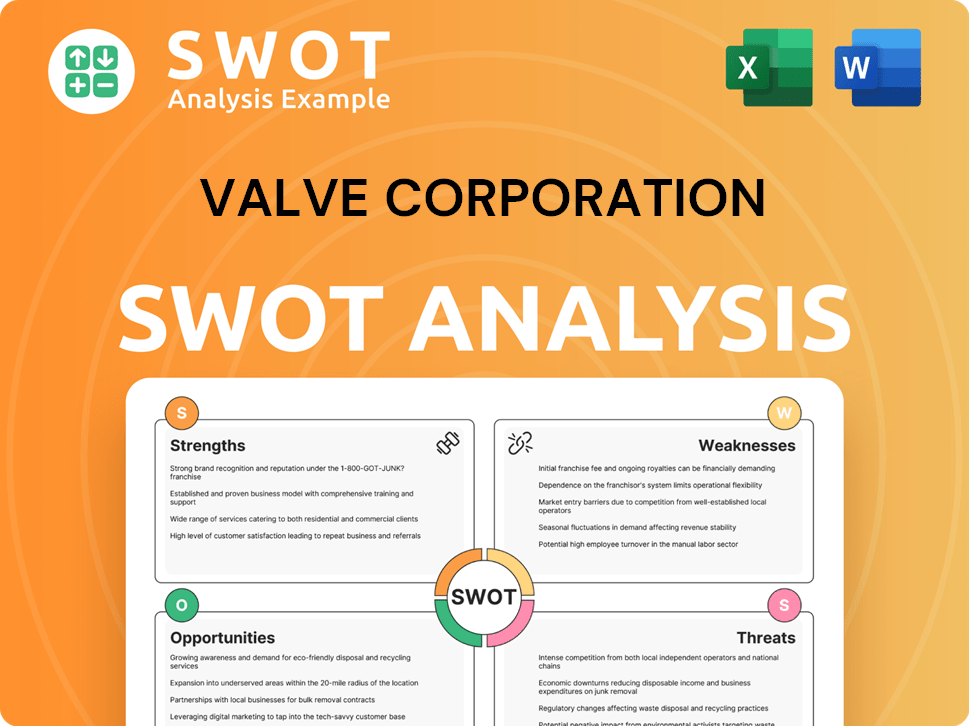
How Does Valve Corporation Make Money?
The primary revenue streams for Valve Corporation, often referred to as Valve Company, are centered around its digital distribution platform, Steam. While specific financial details are not publicly available, the company's monetization strategies are well-defined and primarily revolve around game sales and in-game transactions.
Valve's business model leverages its massive user base and extensive content library to drive recurring transactions and maintain a dominant market position in the gaming industry. This approach has allowed Valve to become a leading video game developer and a major player in the digital distribution space.
The company's success is closely tied to the Steam platform, which offers a wide range of games and services. Understanding how Valve generates revenue is crucial for anyone interested in the company's operations and its impact on the gaming industry.
Valve's revenue generation is multifaceted, with several key sources contributing to its financial performance. These streams include direct game sales, in-game purchases, and the Steam Community Market, all of which are integral to the company's financial success. The company's ability to innovate and adapt its monetization strategies has been key to its sustained growth and market leadership. For a deeper dive into the company's growth trajectory, consider reading about the Growth Strategy of Valve Corporation.
- Game Sales: Valve earns a percentage of each game sold on Steam. Historically, the company has taken a 30% cut, although this can vary.
- In-Game Transactions: Significant revenue comes from virtual items, cosmetics, and downloadable content within games like Dota 2 and Counter-Strike 2.
- Steam Community Market: Users buy and sell in-game items, with Valve taking a transaction fee, typically between 5% and 15%.
- Hardware Sales: The Steam Deck, a portable gaming device, contributes to revenue. By October 2024, over 3 million units had been sold.
Valve Corporation PESTLE Analysis
- Covers All 6 PESTLE Categories
- No Research Needed – Save Hours of Work
- Built by Experts, Trusted by Consultants
- Instant Download, Ready to Use
- 100% Editable, Fully Customizable
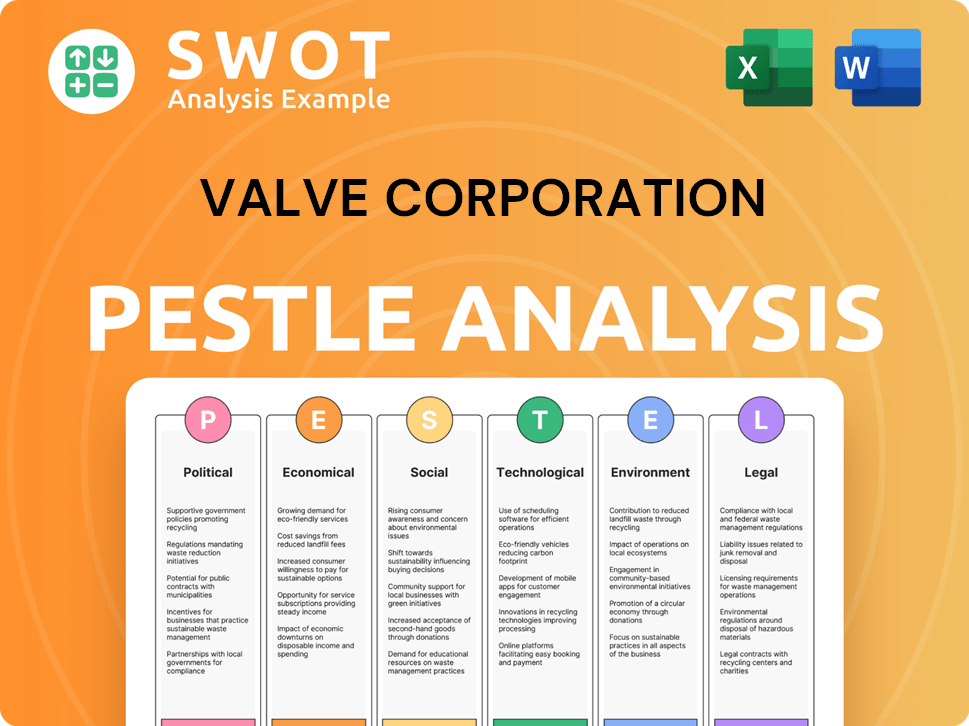
Which Strategic Decisions Have Shaped Valve Corporation’s Business Model?
The story of Valve Corporation, often referred to as Valve, is a compelling narrative of innovation and strategic foresight within the gaming industry. From its inception, the company has consistently redefined how games are developed, distributed, and experienced. This approach has solidified its position as a leading video game developer and a pivotal force in the digital distribution landscape.
Valve's journey is marked by several pivotal milestones that have cemented its position in the gaming industry. The launch of Steam in 2003 was a groundbreaking strategic move, transforming PC game distribution from physical media to digital downloads, a paradigm shift that many initially resisted but eventually adopted. The release of Half-Life 2 in 2004, a critical and commercial success, further solidified Steam's necessity for accessing Valve's flagship titles. The introduction of the Steam Community in 2007 and the Steam Workshop in 2011 fostered a robust user-generated content ecosystem, greatly enhancing user engagement and content variety.
The company's competitive advantages include its unparalleled brand strength within PC gaming, its technological leadership in platform development, and the significant economies of scale derived from its massive user base and content offerings. The Steam ecosystem, with its integrated social features, marketplace, and developer tools, creates a powerful lock-in effect for both players and creators. Valve continues to adapt by investing in new technologies like virtual reality (e.g., Valve Index) and exploring new hardware form factors, ensuring its continued relevance in a dynamic industry.
Valve's history is punctuated by significant milestones. The launch of Steam in 2003 was a game-changer, moving PC game distribution online. The release of Half-Life 2 in 2004, and the introduction of Steam Community in 2007 and Steam Workshop in 2011, further enhanced the platform's appeal. The launch of the Steam Deck in 2022 expanded into hardware.
Strategic moves have defined Valve's trajectory. Shifting to free-to-play models for games like Dota 2 and Counter-Strike: Global Offensive broadened its user base. The Steam Deck launch was a foray into hardware, extending the Steam ecosystem. Continuous enhancement of Steam's features and community tools is a key strategy.
Valve's competitive edge lies in its brand strength, technological leadership, and economies of scale. The Steam ecosystem, with its social features and marketplace, creates a strong lock-in effect. Investment in VR and new hardware form factors ensures continued relevance. The company's approach to game design and its relationship with its community are also crucial.
Valve faces competition from digital storefronts like the Epic Games Store. Its response involves enhancing Steam's features, community tools, and content library. The company's ability to adapt and innovate is crucial. The gaming market is dynamic, requiring constant evolution to maintain a competitive advantage.
Valve's ability to adapt to market changes and innovate has been key to its success. The company's continuous investment in new technologies, such as virtual reality, and its exploration of new hardware form factors, like the Steam Deck, demonstrate its commitment to staying at the forefront of the gaming industry. Valve's approach to game design, community engagement, and customer support further solidifies its position. For a deeper dive into Valve's operations, you can read more about the company's structure and strategies in this comprehensive article about Valve Corporation.
- Valve's adaptability is crucial in a dynamic market.
- The company invests in new technologies like VR and hardware.
- Strong community engagement enhances its market position.
- Continuous innovation is key to maintaining a competitive edge.
Valve Corporation Business Model Canvas
- Complete 9-Block Business Model Canvas
- Effortlessly Communicate Your Business Strategy
- Investor-Ready BMC Format
- 100% Editable and Customizable
- Clear and Structured Layout
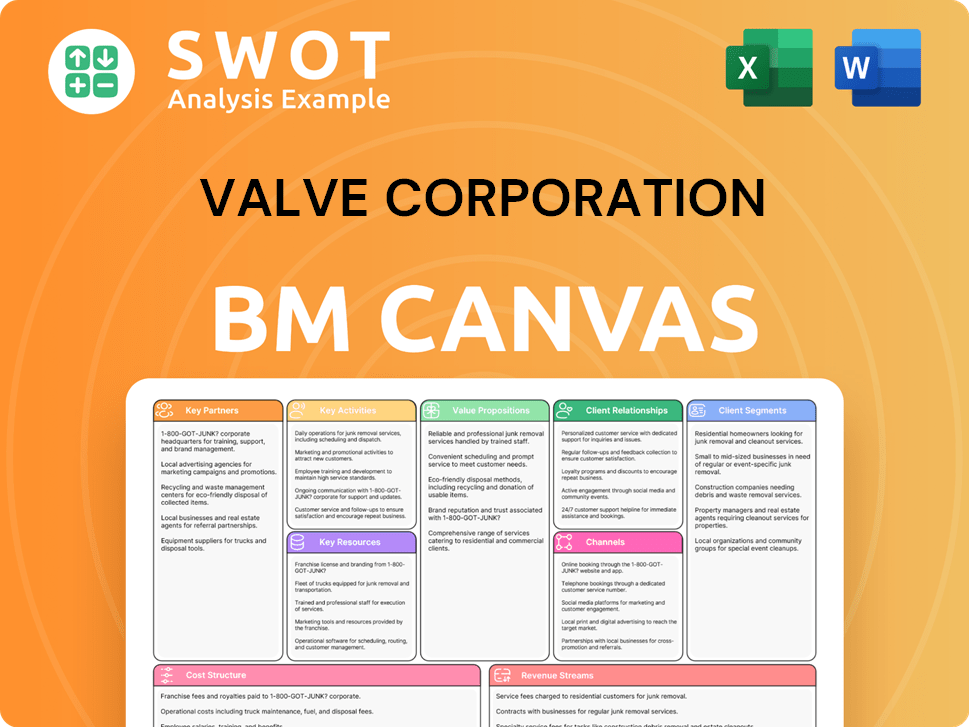
How Is Valve Corporation Positioning Itself for Continued Success?
The Valve Corporation holds a dominant position in the PC digital game distribution market through its Steam platform. As of early 2025, Steam's market share is estimated to be well above 50%, possibly reaching as high as 75% or more, solidifying its status as a leader in the industry. This strong market presence is a result of years of consistent service, a vast game library, and strong community features, which have built exceptional customer loyalty.
Despite its robust position, Valve Company faces several key risks, including regulatory changes, emerging competition, and technological disruptions. The company must navigate these challenges while adapting to evolving consumer preferences and maintaining its innovative edge. The company's future success depends on its ability to adapt and expand, ensuring its continued relevance in the fast-paced gaming industry.
Steam's dominance in PC digital game distribution is substantial, with a market share estimated to be between 50% and 75% as of early 2025. This strong position is supported by a vast library of games, robust community features, and consistent service. Its global reach is almost unparalleled in PC gaming, with users across the globe.
Key risks include regulatory scrutiny, antitrust concerns, and potential changes to platform fees. New competitors and technological disruptions, such as cloud gaming, could erode market share. Consumer preference shifts towards subscription models also pose a challenge.
Valve's future involves sustained platform enhancement, hardware innovation, and strategic expansion. The company continues to invest in the Steam Deck ecosystem and explore new technologies. Leadership focuses on open platforms and empowering developers.
Ongoing initiatives include improving the Steam user experience and expanding its content library. Valve aims to attract new users and adapt to industry trends. Careful navigation of regulatory and competitive challenges is crucial for continued success. For more insights, consider reading about the Growth Strategy of Valve Corporation.
The Valve Corporation's success hinges on several key factors, including its ability to adapt to changing market dynamics and maintain its competitive edge. Continuous innovation, strategic partnerships, and a strong focus on customer satisfaction are essential for long-term growth. The company must also address potential regulatory challenges and competitive threats to sustain its market position.
- Regulatory Compliance: Navigating antitrust concerns and platform fee regulations.
- Technological Adaptation: Embracing cloud gaming and other emerging technologies.
- Market Expansion: Exploring new markets and expanding the content library.
- Competition: Addressing the rise of new competitors in the digital distribution space.
Valve Corporation Porter's Five Forces Analysis
- Covers All 5 Competitive Forces in Detail
- Structured for Consultants, Students, and Founders
- 100% Editable in Microsoft Word & Excel
- Instant Digital Download – Use Immediately
- Compatible with Mac & PC – Fully Unlocked
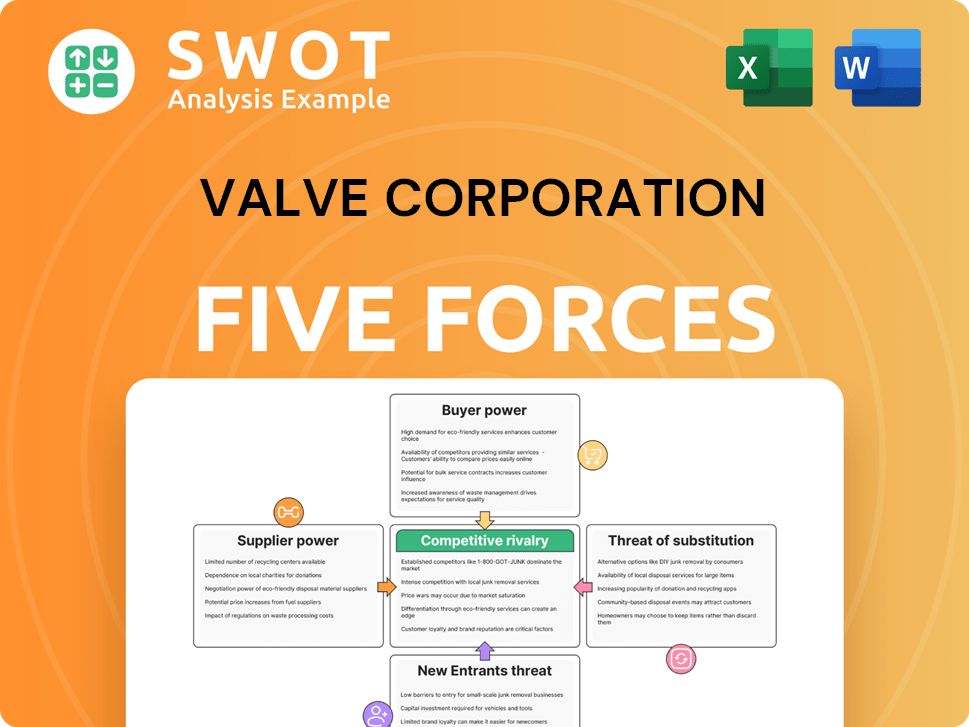
Related Blogs
- What are Mission Vision & Core Values of Valve Corporation Company?
- What is Competitive Landscape of Valve Corporation Company?
- What is Growth Strategy and Future Prospects of Valve Corporation Company?
- What is Sales and Marketing Strategy of Valve Corporation Company?
- What is Brief History of Valve Corporation Company?
- Who Owns Valve Corporation Company?
- What is Customer Demographics and Target Market of Valve Corporation Company?
Disclaimer
All information, articles, and product details provided on this website are for general informational and educational purposes only. We do not claim any ownership over, nor do we intend to infringe upon, any trademarks, copyrights, logos, brand names, or other intellectual property mentioned or depicted on this site. Such intellectual property remains the property of its respective owners, and any references here are made solely for identification or informational purposes, without implying any affiliation, endorsement, or partnership.
We make no representations or warranties, express or implied, regarding the accuracy, completeness, or suitability of any content or products presented. Nothing on this website should be construed as legal, tax, investment, financial, medical, or other professional advice. In addition, no part of this site—including articles or product references—constitutes a solicitation, recommendation, endorsement, advertisement, or offer to buy or sell any securities, franchises, or other financial instruments, particularly in jurisdictions where such activity would be unlawful.
All content is of a general nature and may not address the specific circumstances of any individual or entity. It is not a substitute for professional advice or services. Any actions you take based on the information provided here are strictly at your own risk. You accept full responsibility for any decisions or outcomes arising from your use of this website and agree to release us from any liability in connection with your use of, or reliance upon, the content or products found herein.